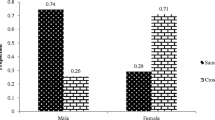Abstract
In this study we re-examine the role of genderwithin the self-concept and challenge the assumptionthat our gender self-concept is static and consistentacross contexts. We used the Bem Sex Role Inventory (BSRI) to measure masculinity and femininityacross six contexts. These six contexts were interactingwith same sex friends, interacting with other sexfriends, interacting at home, work, and school, and interacting in a social context where one doesnot know many people. Two hundred twenty-three femalesand 52 males from a large public university in theSoutheast participated in the study. A majority of the participants (76%) were Caucasian with 10%being Hispanic, 4% Asian, and 4% African American.Multivariate analyses of variance provided strongevidence for differences across contexts for both males and females. The results indicated that we aredynamic beings and those characteristics associated withgender are dynamic as well.
Similar content being viewed by others
REFERENCES
Bem, S. (1974). The measurement of psychological androgyny. Journal of Consulting and Clinical Psychology, 42, 155–162.
Bem, S. (1975). Sex role adaptability: One consequence of psychological androgyny. Journal of Personality and Social Psychology, 31, 634–643.
Bem, S. (1981). Gender schema theory: A cognitive account of sex typing. Psychological Review, 88, 354–364.
Bem, S. (1993). The lenses of gender: Transforming the debate on sexual inequality. New Haven, CT: Yale University Press.
Dailey, D., & Rosenzweig, J. (1988). Variations in men's psychological sex role self-perception as a function of work, social and sexual life roles. Journal of Sex & Marital Therapy, 14, 225–240.
Deaux, K., & Major, B. (1987). Putting gender into context: An interactive model of genderrelated behavior. Psychological Review, 94, 369–389.
Eagly, A. (1987). Sex differences in social behavior: A social-role interpretation. Hillsdale, NJ: Lawrence Erlbaum Associates.
Heilbrun, A. (1986). Androgyny as type and androgyny as behavior: Implications for gender schema in males and females. Sex Roles, 14, 123–139.
Katz, R., Hannon, R., & Whitten, L. (1996). Effects of gender and situation on the perception of sexual harrassment. Sex Roles, 34, 35–42.
Keppel, G. (1991). Design and analysis: A researcher's handbook (3rd ed.). Englewood Cliffs, NJ: Prentice-Hall.
Maccoby, E. (1988). Gender as a social category. Developmental Psychology, 24, 755–765.
Maccoby, E. (1990). Gender and relationships: A developmental account. American Psychologist, 45, 513–530.
Maccoby, E., & Jacklin, C. (1974). The psychology of sex differences. Stanford, CA: Stanford University Press.
Sherif, C. (1979). Bias in psychology. In J. Sherman & E. Beck (Eds.), The prism of sex: Essays in the sociology of knowledge. Madison. University of Wisconsin Press.
Sherif, C. (1982). Needed concepts in the study of gende ridentity. Psychology of Women Quarterly, 6, 375–398.
Spence, J., & Helmreich, R. (1981). Androgyny versus gender schema: A comment on Bem's gender schema theory. Psychological Review, 88, 365–368.
Tabachnick, B., & Fidell, L. (1996). Using multivariate statistics (3rd ed.). New York: Harper Collins Publishers.
Williams, J., & Bennett, S. (1975). The definition of sex stereotypes via the Adjective Check List. Sex Roles, 1, 327–337.
Rights and permissions
About this article
Cite this article
Smith, C.J., Noll, J.A. & Bryant, J.B. The Effect of Social Context on Gender Self-Concept. Sex Roles 40, 499–512 (1999). https://doi.org/10.1023/A:1018879811991
Issue Date:
DOI: https://doi.org/10.1023/A:1018879811991




